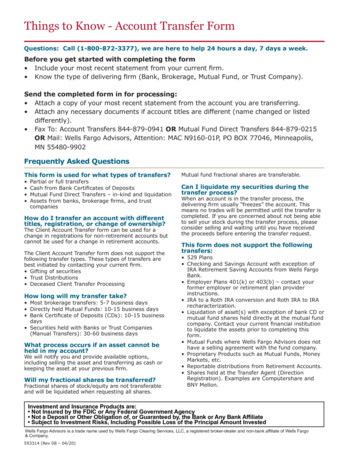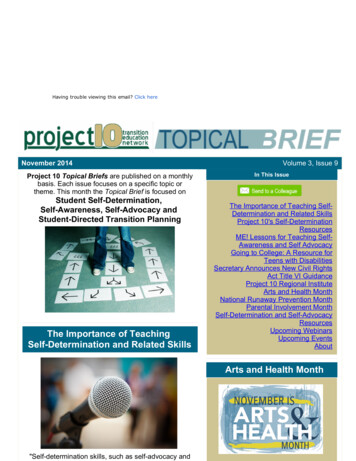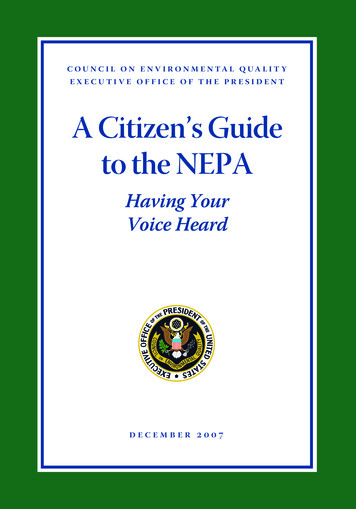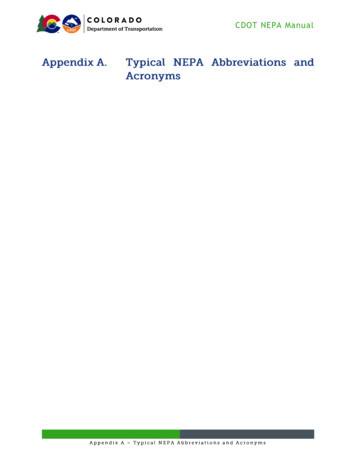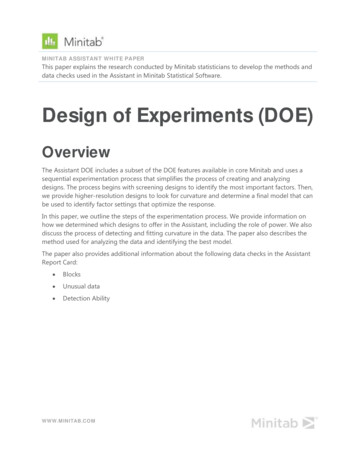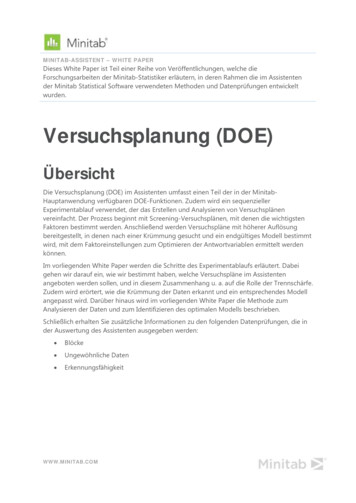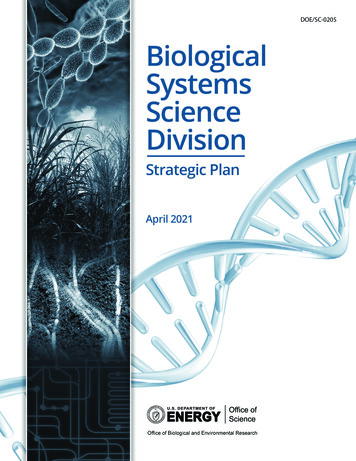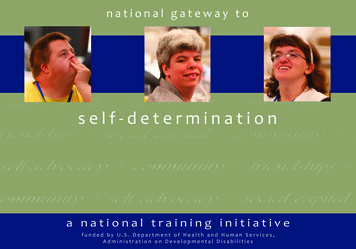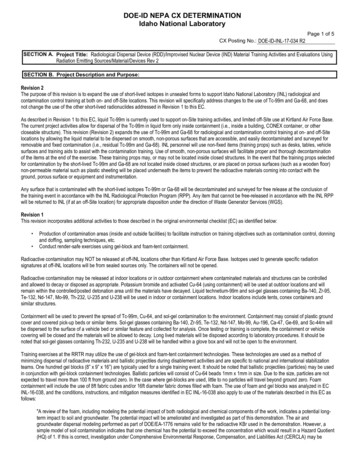
Transcription
DOE-ID NEPA CX DETERMINATIONIdaho National LaboratoryPage 1 of 5CX Posting No.: DOE-ID-INL-17-034 R2SECTION A. Project Title: Radiological Dispersal Device (RDD)/Improvised Nuclear Device (IND) Material Training Activities and Evaluations UsingRadiation Emitting Sources/Material/Devices Rev 2SECTION B. Project Description and Purpose:Revision 2The purpose of this revision is to expand the use of short-lived isotopes in unsealed forms to support Idaho National Laboratory (INL) radiological andcontamination control training at both on- and off-Site locations. This revision will specifically address changes to the use of Tc-99m and Ga-68, and doesnot change the use of the other short-lived radionuclides addressed in Revision 1 to this EC.As described in Revision 1 to this EC, liquid Tc-99m is currently used to support on-Site training activities, and limited off-Site use at Kirtland Air Force Base.The current project activities allow for dispersal of the Tc-99m in liquid form only inside containment (i.e., inside a building, CONEX container, or othercloseable structure). This revision (Revision 2) expands the use of Tc-99m and Ga-68 for radiological and contamination control training at on- and off-Sitelocations by allowing the liquid material to be dispersed on smooth, non-porous surfaces that are accessible, and easily decontaminated and surveyed forremovable and fixed contamination (i.e., residual Tc-99m and Ga-68). INL personnel will use non-fixed items (training props) such as desks, tables, vehiclesurfaces and training aids to assist with the contamination training. Use of smooth, non-porous surfaces will facilitate proper and thorough decontaminationof the items at the end of the exercise. These training props may, or may not be located inside closed structures. In the event that the training props selectedfor contamination by the short-lived Tc-99m and Ga-68 are not located inside closed structures, or are placed on porous surfaces (such as a wooden floor)non-permeable material such as plastic sheeting will be placed underneath the items to prevent the radioactive materials coming into contact with theground, porous surface or equipment and instrumentation.Any surface that is contaminated with the short-lived isotopes Tc-99m or Ga-68 will be decontaminated and surveyed for free release at the conclusion ofthe training event in accordance with the INL Radiological Protection Program (RPP). Any item that cannot be free-released in accordance with the INL RPPwill be returned to INL (if at an off-Site location) for appropriate disposition under the direction of Waste Generator Services (WGS).Revision 1This revision incorporates additional activities to those described in the original environmental checklist (EC) as identified below: Production of contamination areas (inside and outside facilities) to facilitate instruction on training objectives such as contamination control, donningand doffing, sampling techniques, etc.Conduct render-safe exercises using gel-block and foam-tent containment.Radioactive contamination may NOT be released at off-INL locations other than Kirtland Air Force Base. Isotopes used to generate specific radiationsignatures at off-INL locations will be from sealed sources only. The containers will not be opened.Radioactive contamination may be released at indoor locations or in outdoor containment where contaminated materials and structures can be controlledand allowed to decay or disposed as appropriate. Potassium bromide and activated Cu-64 (using containment) will be used at outdoor locations and willremain within the controlled/posted detonation area until the materials have decayed. Liquid technetium-99m and sol-gel glasses containing Ba-140, Zr-95,Te-132, Nd-147, Mo-99, Th-232, U-235 and U-238 will be used in indoor or containment locations. Indoor locations include tents, conex containers andsimilar structures.Containment will be used to prevent the spread of Tc-99m, Cu-64, and sol-gel contamination to the environment. Containment may consist of plastic groundcover and covered pick-up beds or similar items. Sol-gel glasses containing Ba-140, Zr-95, Te-132, Nd-147, Mo-99, Au-196, Ca-47, Ge-69, and Sc-44m willbe dispersed to the surface of a vehicle bed or similar feature and collected for analysis. Once testing or training is complete, the containment or vehiclecovering will be closed and the materials will be allowed to decay. Long lived materials will be disposed according to laboratory procedures. It should benoted that sol-gel glasses containing Th-232, U-235 and U-238 will be handled within a glove box and will not be open to the environment.Training exercises at the RRTR may utilize the use of gel-block and foam-tent containment technologies. These technologies are used as a method ofminimizing dispersal of radioactive materials and ballistic projectiles during disablement activities and are specific to national and international stabilizationteams. One hundred gel blocks (8” x 9” x 16”) are typically used for a single training event. It should be noted that ballistic projectiles (particles) may be usedin conjunction with gel-block containment technologies. Ballistic particles will consist of Cu-64 beads 1mm x 1mm in size. Due to the size, particles are notexpected to travel more than 100 ft from ground zero. In the case where gel-blocks are used, little to no particles will travel beyond ground zero. Foamcontainment will include the use of 8ft fabric cubes and/or 16ft diameter fabric domes filled with foam. The use of foam and gel blocks was analyzed in ECINL-16-038, and the conditions, instructions, and mitigation measures identified in EC INL-16-038 also apply to use of the materials described in this EC asfollows:"A review of the foam, including modeling the potential impact of both radiological and chemical components of the work, indicates a potential longterm impact to soil and groundwater. The potential impact will be ameliorated and investigated as part of this demonstration. The air andgroundwater dispersal modeling performed as part of DOE/EA-1776 remains valid for the radioactive KBr used in the demonstration. However, asimple model of soil contamination indicates that one chemical has the potential to exceed the concentration which would result in a Hazard Quotient(HQ) of 1. If this is correct, investigation under Comprehensive Environmental Response, Compensation, and Liabilities Act (CERCLA) may be
DOE-ID NEPA CX DETERMINATIONIdaho National LaboratoryPage 2 of 5CX Posting No.: DOE-ID-INL-17-034 R2required. In addition, GWScreen modeling indicates that repeated use of the foam over time may result groundwater concentrations which mayrequire CERCLA investigation."The following measures will be taken to investigate and mitigate these modeling indicators:1. Soil contaminated with dispersed/collapsed foam will be sampled over a period of 30 days to identify the actual initial chemicalconcentration and any reduction in concentration over time due to environmental or biological degradation.2. After 30 days of radioactive decay and sampling, contaminated soil may be left in place if actual soil concentrations do not exceed aCERCLA HQ of 1. If the HQ exceeds 1, all contaminated soil will be excavated and disposed as non-radioactive waste.3. GWScreen modeling indicates that a single use of the foam does not result in groundwater contamination. This EC approves only one useof the foam. This EC will be revised to address additional use of foam IF data on the actual soil concentration results in GWScreenmodeling which demonstrates groundwater contamination is not an issue. If potential groundwater contamination remains an issue,preventive measures such as use of secondary containment for the foam may allow additional future use of the foam.4. Soil sampling results will be used to determine if future or repeated use of foam would require soil excavation and disposal. If soilcontamination remains an issue, preventive measures such as use of secondary containment for the foam may allow additional future useof the foam.5. During the 30-day decay and sampling period, the area around the contamination will be fenced to exclude stock and small animals. Itshould be noted that use of the foam material at off-INL locations showed that wildlife (rodents/mammals/birds) was not attracted to thedispersed foam."Secondary containment will be used when the use of Cu-64 with gel-block or foam containment is proposed.The use of training aides will be used to support RDD/IND training courses. Training aides include various real-world props such as vehicles (cars, trucks,buses, planes, trailers, etc.), external vehicle parts, concrete barriers and blocks, steel beams, walls and buildings and materials of various construction. Allvehicles will be drained of fluids and hazardous materials removed prior to use. A combination of these training aides may be used to create a rubble pile tomimic a collapsed structure.On occasion, testing of detection equipment (vehicle and drone mounted, air-samplers) and techniques is performed in concert with RRTR training activities.For vehicle mounted systems, the external RRTR activities will be conducted on established two-track roads. Testing will include the use of sealed sourcesto produce radiation fields of post RDD and IND radiation environments. This work will be conducted under LI-344 “RDD Material Training Activities andEvaluations using Radiation Emitting Sources and/or Devices.”Training Exercises at the off-INL non-Federal LocationsOff-INL locations in Eastern Idaho that have been used in the past include Melaleuca Field in Idaho Falls, Eastern Idaho Fairgrounds in Blackfoot, SandyDowns racetrack in Idaho Falls, and Holt Arena in Pocatello. Other locations in the western region may include locations such as Snowbird Ski Resort inUtah. Work at off-INL non-federal locations will only occur with the approval of the lease holder (or similar) and/or property owner.The major equipment used in this activity include: radiation producing equipment such as radioisotopes, x-ray and gamma ray generating equipment andirradiated materials, such as, uranium and plutonium sources that have been irradiated to supply a source of fission products. The project will limit SpecialNuclear Materials to Category IV or less and manage, use, and store the material in compliance with INL and BEA procedures.Isotopes used to generate specific radiation signatures may be commercially available medical isotopes in sealed containers. The containers will not beopened.There will be no dispersals of radioactive material at off-INL locations in Eastern Idaho. Dispersal off of the INL Site will only occur at federal installations(e.g., Department of Defense sites, military bases, etc.). Those installations would conduct their own NEPA reviews.Portable/mobile electrical generators may be used to support temporary work locations.Original ECThis Environmental Checklist (EC) will cover future training as described in this EC.The purpose of this EC is to plan, prepare, coordinate, ship materials off-site, observe, and conduct training for response to radiological incidents at theIdaho National Laboratory (INL) locations, off-INL locations in Eastern Idaho, and off-INL Federal customer-hosted locations (such as Armed Forcesinstallations). This EC covers work performed at the INL and off-INL Eastern Idaho locations. Training at off-INL customer-hosted locations may be subjectto additional National Environmental Policy Act of 1969 (NEPA) review performed by the customer. The term “INL locations” includes site and in-townfacilities, such as EIL, where there is approval to use sealed sources. Off-INL locations in Eastern Idaho include Melaleuca Field in Idaho Falls, EasternIdaho Fairgrounds in Blackfoot, Sandy Downs racetrack in Idaho Falls, and Holt Arena in Pocatello. Work at off-INL area will only occur with the approval ofthe property owner.The INL conducts training activities using radiological and nuclear materials to support programs both on- and off-site as part of the INL, Homeland Security(N&HS), Nuclear Nonproliferation Division (NND) activities. The work activities may include the following:
DOE-ID NEPA CX DETERMINATIONIdaho National LaboratoryPage 3 of 5CX Posting No.: DOE-ID-INL-17-034 R2 Performing measurements on targets using x-ray, and gamma ray radiation producing equipment such as portable x-ray generators, Betatrons andradioisotope sources.Creating radiation fields for training and exercises that emulate pre- and post-RDD and IND radiation environments.Creating contamination areas (inside facilities) to facilitate instruction on training objectives such as contamination control, donning/doffing,sampling techniques, etc.Examining the effects and influence of radiation on equipment and measurement devices.Validating techniques, procedures, and processes that respective teams use in response to events involving radioactive materials.Activities that are performed to support the above objectives include: Using only Category IV or less quantity of Special Nuclear Materials.Following INL and Battelle Energy Alliance, LLC (BEA) procedures for using fissionable material.Storing and transferring nuclear materials in compliance with INL and BEA procedures.Supplying the resources to receive, transport, and return radiological/nuclear materials for INL locations.Supplying the resources to receive, transport, and return radiological/nuclear materials for off-INL locations in compliance with NRC requirements.Handling and staging radioactive materials and sources.Operating radiation generating devices/equipment.Achieving training and exercise objectives through demonstrating equipment and supervising activities in a controller/evaluator position.Supervising, through Health Physics/Radiation Control, the handling of radiological/nuclear materials and work in radiologically controlled areas thatinclude both staging and supporting the exercise and training and participating in the exercise and training.Supplying radioactive sources to set up radiation fields for the exercise and emulate radioactive samples collected from the field.Conducting dosimetry training for participants, as needed.The project approach is to assemble the equipment, personnel, radiological/nuclear materials and sources, and procedures to be able to conduct the trainingat the INL or to transport a training activity or exercise event to locations that are not equipped to do such activities. At the end of each off INL trainingactivity the equipment and sources will be returned to the INL or transferred to the next training activity.The RDD/IND Material Training Course is designed to allow participants to train and exercise in near real life radiological environments where they areexpected to use their training to do measurements, interrogate materials, perform radiation/contamination surveys and collect radioactive, potentiallycontaminated samples that might be associated with an IND or RDD. Sealed sources may be used at training venues. At INL locations and at Kirtland AirForce Base, radioactive contamination may be released at indoor locations where contaminated materials/structures can be controlled and allowed to decayor disposed as radioactive waste; radioactive contamination may NOT be released at other off-INL locations. Isotopes used to generate indoorcontamination areas will be short-lived such that decay to unregulated levels can be expected in less than 60 days. Isotopes used to generate indoorcontamination areas or specific radiation signatures may be generated on-site or may be commercially available medical isotopes.Training Exercises at the INLThe term “INL locations” includes site and in-town facilities, such as EIL, where there is approval for using sealed sources.Training exercises at the INL may include material/surface decontamination using basic methods such as wipes and application of less than 25 gallons ofdecontamination solution. Project personnel will review solutions before application, to identify management requirements for subsequent waste such asrags and excess decontamination solution.The major equipment used in this activity include: radiation producing equipment such as radioisotopes, x-ray and gamma ray generating equipment andirradiated materials, such as, uranium and plutonium sources that have been irradiated to supply a source of fission products. The project will limit SpecialNuclear Materials to Category IV or less manage, use, and store the material in compliance with INL and BEA procedures.Training activities at the INL may take place at a variety of locations such as Zero Power Physics Reactor (ZPPR), Transient Reactor Experiment and TestFacility (TREAT), Central Facilities Area (CFA), and (CITRC). This work may be combined with exercises at the Radiological Response Training Ranges(RRTR) and the National Security Test Range (NSTR). Training will typically take place at already disturbed facilities rather than undisturbed areas of theINL. An exercise in an otherwise undisturbed INL location is not covered under this EC and requires a separate EC. RDD/IND "defeat" devices usingthermites, kinetic or explosive energy will be used only at the NSTR. Defeat devices will not result in the release of radioactive material or contamination.Training at INL Site areas such as the CITRC facility will generally stay on paved areas and in structures/buildings. Minor work in adjoining vegetated areasmay take place subject to more review and approval by Cultural and Biological personnel. "Minor work" is defined as foot travel or work in which mowing orvegetation destruction/removal is not required. Soil disturbance may include taking samples at depths up to six inches.Solid and liquid wastes will be collected in containers. Low-Level Radioactive waste may be stored for a time to allow radioactive decay followed by disposalas non-radioactive waste. Portable sanitary facilities may be staged in support of a training exercise. Effluent may be disposed at the CFA sewage treatmentplant or at an off-site municipal sewer system. As an alternative to portable sanitary facilities, permanent facilities may also be used.Portable/mobile electrical generators may be used to support temporary work locations.Training Exercises at the off-INL Eastern Idaho Locations
DOE-ID NEPA CX DETERMINATIONIdaho National LaboratoryPage 4 of 5CX Posting No.: DOE-ID-INL-17-034 R2Off-INL locations in Eastern Idaho include Melaleuca Field in Idaho Falls, Eastern Idaho Fairgrounds in Blackfoot, Sandy Downs racetrack in Idaho Falls,and Holt Arena in Pocatello. Work at off-INL area will only occur with the approval of the property owner.The major equipment used in this activity include: radiation producing equipment such as radioisotopes, x-ray and gamma ray generating equipment andirradiated materials, such as, uranium and plutonium sources that have been irradiated to supply a source of fission products. The project will limit SpecialNuclear Materials to Category IV or less manage, use, and store the material in compliance with INL and BEA procedures.Isotopes used to generate specific radiation signatures may be commercially available medical isotopes in sealed containers. The containers will not beopened.There will be no dispersals of radioactive material at off-INL locations in Eastern Idaho.Portable/mobile electrical generators may be used to support temporary work locations.Training Exercises at Other Federal FacilitiesTraining at off-INL customer-hosted locations may be subject to additional National Environmental Policy Act of 1969 (NEPA) review performed by thecustomer.The major equipment used in this activity include: radiation producing equipment such as radioisotopes, x-ray and gamma ray generating equipment andirradiated materials, such as, uranium and plutonium sources that have been irradiated to supply a source of fission products. The project will limit SpecialNuclear Materials to Category IV or less manage, use, and store the material in compliance with INL and BEA procedures.Dispersals of radioactive material (including medical isotopes) may only take place at Kirtland AFB. These dispersals will be inside of a conex container.Portable/mobile electrical generators may be used to support temporary work locations.SECTION C. Environmental Aspects or Potential Sources of Impact:Air EmissionsProject activities may create fugitive dust during project activities that disturb soil.Air emissions from engines are expected to be the primary air contaminant. Air emissions are expected to include exhaust from portable/mobileelectrical generators, ATVs, and potential radioactive emissions to the air from buildings. Generators will be in place for periods much less than oneyear so no permitting is required. Air emissions may also occur from ATVs and other mobile sources. Exhaust emissions are not regulated. Potentialradioactive emissions will be considered in the annual Rad NESHAPS report.Project activities required the preparation of an APAD.Disturbing Cultural or Biological ResourcesProject activities may occur off-road, disturbing vegetation and soil that may adversely affect cultural artifacts, wildlife habitat (including sagebrush), ornesting birds. If Cultural artifacts are discovered during sampling, the soil will be left in place and the sample will be taken at a different location. Projectpersonnel will notify the INL Cultural Resource Management Office (CRM) of the discovery.The CITRC (the old Power Burst Facility [PBF]) area is known for its richness in cultural artifacts. Personnel participating in training exercises at CITRCwill be required to read a short training document about cultural artifacts before to the training exercise. Figure 1 shows a map of one particularlysensitive area near or next to PBF-622 and -623 that must be excluded from ground disturbancessuch as off-road vehicles, soil sampling and even casual foot traffic.Use of vehicles, including all-terrain vehicles (ATVs), off paved areas and road shoulders duringthe Nesting Bird season needs a Nesting Bird survey no more than two weeks before beginningthe exercise. Use of vehicles, including ATVs, off paved areas or road shoulders at any time willneed review and approval from Biological Resource personnel.Generating and Managing WasteThis work is expected to generate industrial waste, Low-Level radioactive waste, and sanitarywaste. Hazardous or mixed waste is not expected. All waste will have a path for disposition priorto being generated.Industrial waste includes common office trash and non-radioactive sample materials. Commonwash water may also be generated.
DOE-ID NEPA CX DETERMINATIONIdaho National LaboratoryPage 5 of 5CX Posting No.: DOE-ID-INL-17-034 R2Wash water may be discharged to a local septic system or at the CFA sewage treatment plant.Figure 1Low-Level Radioactive waste will include personal protective equipment (PPE) and sample materials. Indoor materials such as furniture, carpet, andsimilar materials may also be contaminated and disposed as radioactive waste if not left in place for decay. Radioactive PPE and decontaminationsolution may be disposed as radioactive waste or stored for decay until cleared by RadCon personnel for disposal as non-radioactive. Liquidradioactive waste may be solidified before disposal in an off-site landfill. Sanitary waste may be disposed at the CFA sewage treatment plant or at apermitted off-INL sewage treatment plant such as the Idaho Falls system.Industrial and Low-Level radioactive waste will be managed by WGS.Activities at off-INL locations in Eastern Idaho are expected to generate only industrial waste as only sealed sources will be used at those locations.That waste will be transported back to INL facilities for disposal.Releasing ContaminantsProject activities will result in intentionally dispersing radioactive material with short half-lives in those areas described in the EC. Typically, the isotopeactivity will be virtually undetectable 30 days after the dispersal.Using, Reusing, and Conserving Natural ResourcesApplicable waste will be diverted from disposal in the landfill when possible.SECTION D. Determine Recommended Level of Environmental Review, Identify Reference(s), and State Justification: Identifythe applicable categorical exclusion from 10 Code of Federal Regulation (CFR) 1021, Appendix B, give the appropriatejustification, and the approval date.For Categorical Exclusions (CXs), the proposed action must not: (1) threaten a violation of applicable statutory, regulatory, or permitrequirements for environmental, safety, and health, or similar requirements of Department of Energy (DOE) or Executive Orders; (2)require siting and construction or major expansion of waste storage, disposal, recovery, or treatment or facilities; (3) disturb hazardoussubstances, pollutants, contaminants, or Comprehensive Environmental Response, Compensation, and Liability Act (CERCLA)excluded petroleum and natural gas products that pre-exist in the environment such that there would be uncontrolled or unpermittedreleases; (4) have the potential to cause significant impacts on environmentally sensitive resources (see 10 CFR 1021). In addition, noextraordinary circumstances related to the proposal exist that would affect the significance of the action. In addition, the action is not“connected” to other action actions (40 CFR 1508.25(a)(1) and is not related to other actions with individually insignificant butcumulatively significant impacts (40 CFR 1608.27(b)(7)).References: 10 CFR 1021, Appendix B to Subpart D categorical exclusion B1.2 "Training exercises and simulations", Idaho National LaboratoryRadiological Response Training Range EA/FONSI (DOE/EA-1776) [October 2010], National Security Test Range EA/FONSI (DOE/EA-1157) [April 2007].Justification: The proposed action is consistent with 10 CFR 1021, Appendix B to Subpart D categorical exclusion B1.2 "Training exercises andsimulations (including, but not limited to, firing-range training, small-scale short-duration force-on-force exercises, emergency response training, fire fighterand rescue training, and decontamination and spill cleanup training) conducted under appropriately controlled conditions and in accordance with applicablerequirements." Project personnel and the Project Environmental Lead will review project activities annually to verify that the work continues to meet the intentof a categorical exclusion and the conditions and project-specific instructions described in this EC.Is the project funded by the American Recovery and Reinvestment Act of 2009 (Recovery Act)Approved by Jason Sturm, DOE-ID NEPA Compliance Officer on: 3/04/2019YesNo
Off-INL locations in Eastern Idaho include Melaleuca Field in Idaho Falls, Eastern Idaho Fairgrounds in Blackfoot, Sandy Downs racetrack in Idaho Falls, and Holt Arena in Pocatello. Work at off-INL area will only occur with the approval of . Homeland Security (N&HS), Nuclear Nonproliferation Division (NND) activities. The work activities may .
